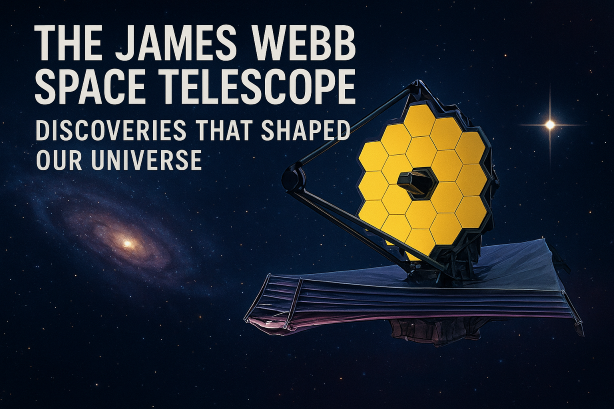Intro: Overview of JWST and Its Mission
The James Webb Space Telescope (JWST) is one of the most ambitious scientific projects ever built. Launched on December 25, 2021, this extraordinary telescope is a joint effort by NASA, ESA (European Space Agency), and CSA (Canadian Space Agency). Designed to look deeper into the universe than ever before, JWST allows us to study the first galaxies, stars, and exoplanets that formed after the Big Bang. With its massive 6.5-meter primary mirror and advanced infrared technology, JWST has already begun to reshape our understanding of space.
Let’s dive into some of its groundbreaking discoveries that are changing the way we view the universe.
Launch & Capabilities
The James Webb Space Telescope was launched aboard an Ariane 5 rocket from French Guiana and now orbits around the second Lagrange point (L2), about 1.5 million kilometers from Earth. Unlike the Hubble Telescope, JWST observes primarily in infrared light, which allows it to peer through cosmic dust and reveal objects hidden from traditional telescopes.
Its advanced instruments — NIR Cam, NIR Spec, MIRI, and FGS/NIRISS — work together to capture detailed data on distant galaxies, planets, and even the atmospheres of exoplanets.
Key Discoveries in Galaxies
One of JWST’s greatest achievements has been the discovery of some of the earliest galaxies ever formed, dating back just a few hundred million years after the Big Bang. These galaxies were much smaller and more chaotic than the ones we see today, helping scientists understand how cosmic structures evolved over billions of years.
By observing the faintest and farthest galaxies, JWST is rewriting cosmic history and giving us clues about how the universe transitioned from darkness into light.
Exoplanet Observations
For the first time, JWST has allowed scientists to study the atmospheres of distant exoplanets with incredible precision. By analyzing the light that passes through these atmospheres, JWST can detect the presence of water vapor, methane, carbon dioxide, and other molecules that may indicate whether a planet could support life.
This ability makes JWST a powerful tool in the search for habitable worlds beyond our solar system.
Deep Space Images
The telescope’s breathtaking deep space images have captured the imagination of people worldwide. From the Carina Nebula’s star-forming regions to the stunning “Cosmic Cliffs” and the detailed view of Stephan’s Quintet, JWST’s images not only hold scientific value but also inspire wonder about the vastness of the universe.
Each image is like a time machine, letting us see billions of years into the past.
Future Missions Inspired by JWST
JWST’s success has already inspired new missions and collaborations in space science. Future telescopes will likely build upon its design, aiming for even greater sensitivity and resolution. Projects like the Nancy Grace Roman Space Telescope and other proposed missions will continue JWST’s legacy by focusing on dark energy, exoplanets, and cosmic expansion.
In many ways, JWST is just the beginning of a new era in astronomy.
Conclusion: JWST’s Long-Term Impact on Astronomy
The James Webb Space Telescope has already delivered discoveries that are reshaping science and our place in the cosmos. From unveiling the earliest galaxies to exploring the atmospheres of alien worlds, JWST is helping humanity answer some of the biggest questions about the universe.
As technology advances and missions expand, the story of JWST will remain a turning point in human exploration of space.






Amazing! The James Webb Space Telescope is truly a giant leap in our understanding of the universe. The way you explained its purpose and discoveries made the topic so easy to understand. Can’t wait to read more from you..!
👍
The James Webb Space Telescope is a true masterpiece of human achievement.
The James web will explain more than old telescope and it will change mind of astrology in future